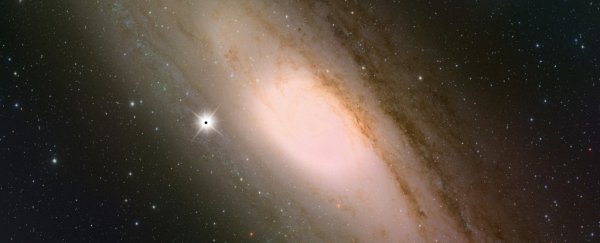We still don't know what dark matter is, but we can strike a line through one option. It is not, as per a theory proposed by the brilliant Stephen Hawking, a bunch of teeny-tiny microscopic black holes.
In the most rigorous test of the theory to date, an international team led by researchers from the Kavli Institute for the Physics and Mathematics of the Universe (IPMU) in Japan has searched for the telltale sign of such minuscule black holes, and the result was pretty damning.
The scientists were hunting for a particular flicker of stars in a nearby galaxy - the way the light would appear to us if a black hole less than a tenth of a millimetre were passing in front of it.
A black hole of that size may seem ludicrous, but the concept actually stems from an elegant theory by Hawking, who was trying to tackle our massive dark matter problem.
The problem is this: based on our observations of the gravitational forces at play in the Universe, we know that 85 percent of the mass out there is created by something we can't see, and are yet to detect directly.
In a 1971 paper, Hawking expanded on the theory of primordial black holes that had been proposed by scientists Yakov Borisovich Zel'dovich and Igor Dmitriyevich Novikov in 1966.
Just after the Big Bang, the theory goes, when the Universe came into being, there could have been regions of matter in the primordial soup that were denser than others - dense enough for gravitational collapse.
Because the resulting black holes didn't form from stars, they could be much less massive - as little as 10-8 kg.
Now, even a titchy black hole has a lot of mass. A black hole with an event horizon 0.1 millimetres in diameter would have a mass of over 67 quintillion metric tons. So, if there were a bunch of these tiny black holes out there - and they hadn't evaporated due to Hawking radiation - they could, conceivably, account for the mass we can't see.
And, if there were a bunch of these black holes out there, zipping around at the tremendous speeds calculated by Hawking, we might see them bending the light of objects they move in front of, an effect called gravitational lensing.
It's this effect the team focused their efforts on. Using the Hyper Suprime Cam on the Subaru Telescope at Mauna Kea in Hawaii, researchers from Japan, India, and the US observed the entirety of the nearby Andromeda Galaxy, capturing 190 consecutive images over a total of seven hours.
If a primordial black hole were to move between us and a star, it's expected that the star would flicker and brighten for a few minutes to hours as the black hole's gravity magnified its light.
The team predicted that the abundance of black holes less massive than the Moon required to produce the effect of dark matter would result in around 1,000 lensing events.
But the observations produced just one potential event - meaning that primordial black holes can be responsible for no more than 0.1 percent of dark matter. (A study last year found that primordial black holes could not possibly account for more than 40 percent of dark matter.)
Which, in effect, means that dark matter isn't made of teeny black holes.
It's unlikely to be the final nail in the theory's coffin - scientists do like to be extremely thorough, after all. But so far, primordial black holes are a nope, and we have to look for dark matter elsewhere.
The research has been published in Nature Astronomy.
